This page on
GitHub
LazyPredator
LazyPredator is a library for evolutionary
computation, a type of population-based optimization
algorithm. It uses genetic
programming where the individuals of the population are
computer programs in a “domain specific language”. The relative
“fitness” or “quality” of these programs is measured in small
“tournaments” where the programs compete against each other. Using
a negative
selection approach, the lower fitness individuals of a
tournament are removed from the population, and replaced by a new
“offspring” of the tournament's higher fitness individuals. (The
offspring is created from parents by “cross-over” and “mutation”
as described here.)
Negative selection implies that lower fitness individuals tend to
die off—while others tend to survive regardless of rank in the
population. Selection of participants in a tournament is “uniform”
not “fitness proportional.” This is the opposite of “elitism” and
related practices in evolutionary computation where the focus is
on identifying and promoting high fitness individuals.
LazyPredator seeks to encourage “genetic drift”—while continuing
to prune the low performing individuals—in order to gradually
improve population fitness.
The name “LazyPredator” refers to this type of negative selection
in nature. A lioness may be capable of running down a healthy
adult antelope. But given the opportunity, she would rather find
easier prey (the young, or old, or injured) so she can obtain food
for her family using less of her own energy. Through this action,
most of the antelope herd will be fit, strong, and fast enough to
survive. At the risk of mixing metaphors, or at least species,
there is a very old joke about this:
Two campers see a bear running toward
them.
One starts putting on running shoes.
The other says, “What are you doing?! You can’t outrun a bear!”
The first says, “I don’t need to outrun the bear — I just need to
outrun you!”
LazyPredator is a sibling of TexSyn a library
for procedural texture synthesis. Together they support
experiments in adversarial evolutionary texture synthesis. I am
especially interested in simulating the evolution of camouflage in
nature, as in this earlier work: Interactive Evolution of
Camouflage.
The code repository for LazyPredator is at GitHub.
(I'm wondering about the writing style of this notebook. The one
for TexSyn was
largely intended to show texture images along with commentary.
When possible, I tried to avoid coding detail. LazyPredator is
about plain old software design, so probably there will be more
discussion here of lower level details of the implementation. On
the other hand, I do want it to be more prose-like than the terse
git commit messages.)
February
9, 2022
Add “validity” flag to TournamentGroup
To support my camouflage work, I needed to better handle the
case where a Tournament fails to establish a
partial ranking of its member Individuals. In the
camouflage simulation, the “predator” needs to pick one of three
camouflaged “prey.” The predator makes its selection by
specifying a location in the image: the human user via a mouse
click, the deep neural net computes an xy value.
But what happens if that location is not inside any of
the three prey? If it is a clean miss? This rarely happens with
a human predator. But it is common with a poorly-performing
neural net predator. In this case, I want the predator to be the
“loser” — and all three prey to survive — on the theory that
they all fooled the predator. Before this change, one of the
three prey would be declared the loser, effectively at random
(based on selection order).
I modified TournamentGroup to add a bool
flag for “validity” along with corresponding accessors getValid()
and setValid(). All TournamentGroup
objects are valid until explicitly set to be invalid.
This allows (say) a TournamentFunction to decide
that the current tournament is invalid and should be canceled. Population::evolutionStep()
will now leave the population unchanged if given a TournamentGroup
which has been marked invalid.
March
25, 2021
Weighting selection of functions for initial random trees
When creating the initial Population of Individuals,
the FunctionSet is filtered to a collection of GpFunctions
with the required return type, and which can terminate GpTree
construction (get to terminals) given the remaining tree “size.”
Previously: one element of the filtered collection was chosen by
uniform random selection. Now that happens by default, but the
c++ initializer for GpFunction can include
an optional extra fifth argument, a float, indicating a selection
weight other than one. Here for example is the “toy”
example used in a new unit test. Each of the four listed GpFunctions
is half as likely to be selected as the next one:
// Define FunctionSet with random selection weightings.
FunctionSet fs = { { { "Int", 0, 9 } },
{ { "L", "Int", {"Int"}, ..., 0.5 },
{ "M", "Int", {"Int"}, ..., 1 },
{ "N", "Int", {"Int"}, ..., 2 },
{ "O", "Int", {"Int"}, ..., 4 }, }, };
Adds new FunctionSet::weightedRandomSelect(), GpFunction::selectionWeight(),
and UnitTests::gp_function_weighted_select().
January
29, 2021
Back and forth on random tournament member uniqueness
Back on October 14 I wrote a Population::selectThreeIndices()
to pick indices of three random Individuals to
form a random tournament. Its purpose was to guarantee the three
Individuals were unique. This was to prevent
forming a competitive tournament between, say, individuals 57,
83, and 57. I am paranoid about “try until success” algorithms
getting stuck in infinite loop. But then I was also hinky about
the statistical properties of my non-iterative solution.
Eventually I decided that when selecting three items out of a
collection of about 100, the frequency of duplication seemed low
enough to ignore, so I just got rid of selectThreeIndices().
(To be sure, there are non-iterative, statistically neutral
solutions to this, they just seemed a bit too heavy-weight to
me. My intuition is famously unreliable.)
Later “subpopulations” (SubPops, breeding demes)
were introduced. Now three Individuals were being
selected from of group of 20-25. When I started running
interactive Camouflage tests, it was visually obvious that a
fair number of tournaments contained duplicated Individuals.
So today I brought back a different implementation of selecting
three unique indices called Population::threeUniqueRandomIndices().
This uses the evil “try until success” approach, but is
liberally sprinkled with calls to assert() meant
to catch any misbehavior, including getting stuck in the loop.
January
17, 2021
Upper and lower bounds on tree size during crossover
As suggested on January 12
LazyPredator now supports both anti-bloat and
“pro-bloat” — that is, both upper and lower bounds on the size
of trees created during crossover. In the “tree size agnostic
case” GP crossover leads to slow but steady growth in
population-average tree size. (That is: the GpTree::size()
of each Individual, averaged over the Population,
grows over time.) Recently I added a size-reducing bias to
crossover when the parent trees are too large. Now the
corresponding size-increasing bias is implemented when parent
trees are too small. These limits can be set to infinity and
zero to deactivate the size biases, but currently
default to 150% and 50% of the given parameter for
initial random tree max size. So for an initial max random tree
size of 100, the size of trees during the run would be on the
range [50, 150]. The limit values can be read or written
which these member functions on a Population
instance:
Population::getMinCrossoverTreeSize()
Population::setMinCrossoverTreeSize()
Population::getMaxCrossoverTreeSize()
Population::setMaxCrossoverTreeSize()
// Update February 3, 2021:
// New Population constructor allows these values to be specified initially:
Population(int individual_count,
int subpopulation_count,
int max_init_tree_size,
int min_crossover_tree_size,
int max_crossover_tree_size,
const FunctionSet& fs)
Here are eight LimitHue runs, four (red) with no limits, and
four (blue) with limits set to enforce tight bounds on tree
size. The only thing to see here is that reds and blues are
roughly the same:
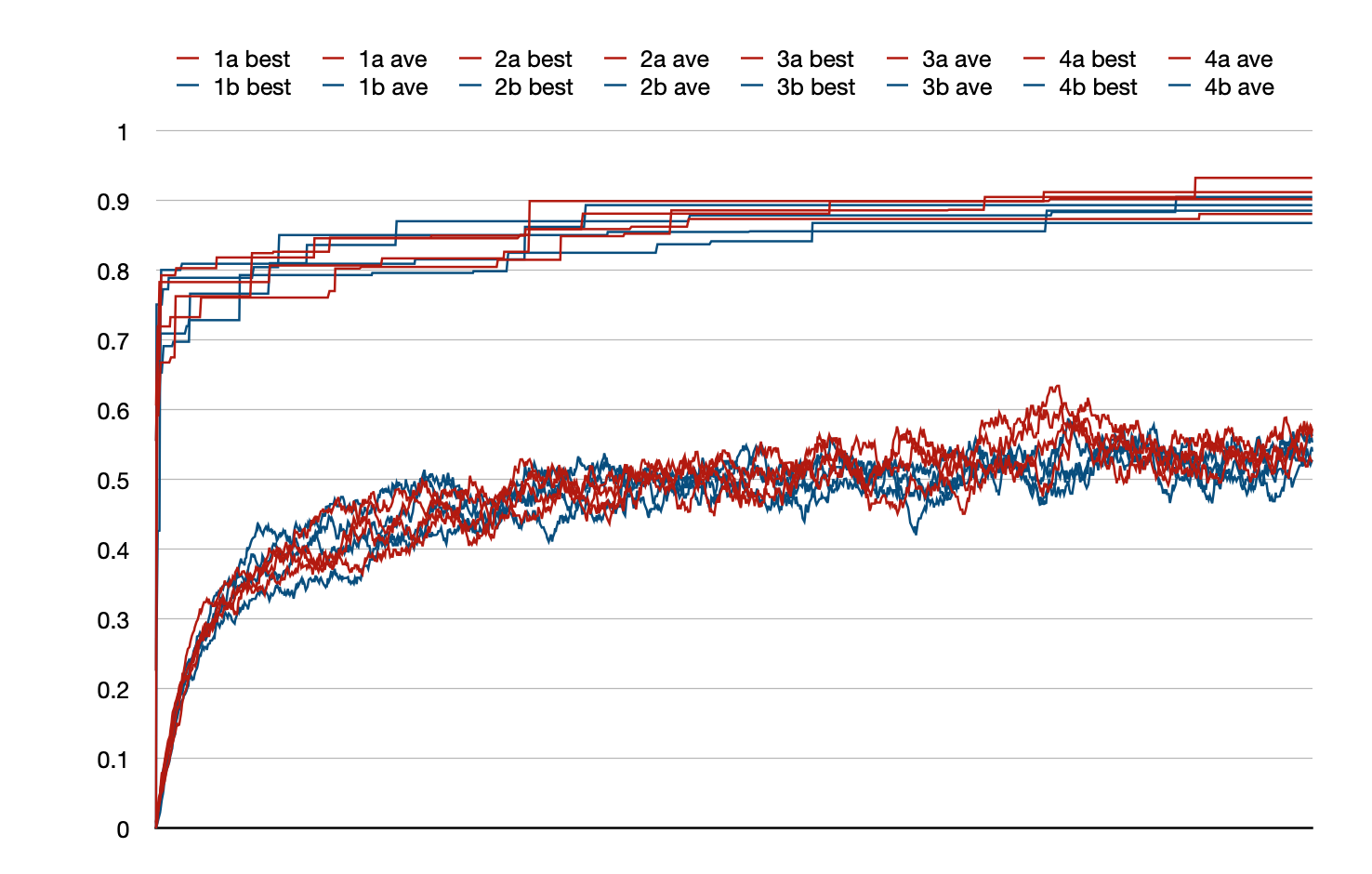
While the fitnesses are about the same in these two
conditions, the no-limits condition (green) show steady growth
in tree size, with limits (orange) stay within a narrow range:
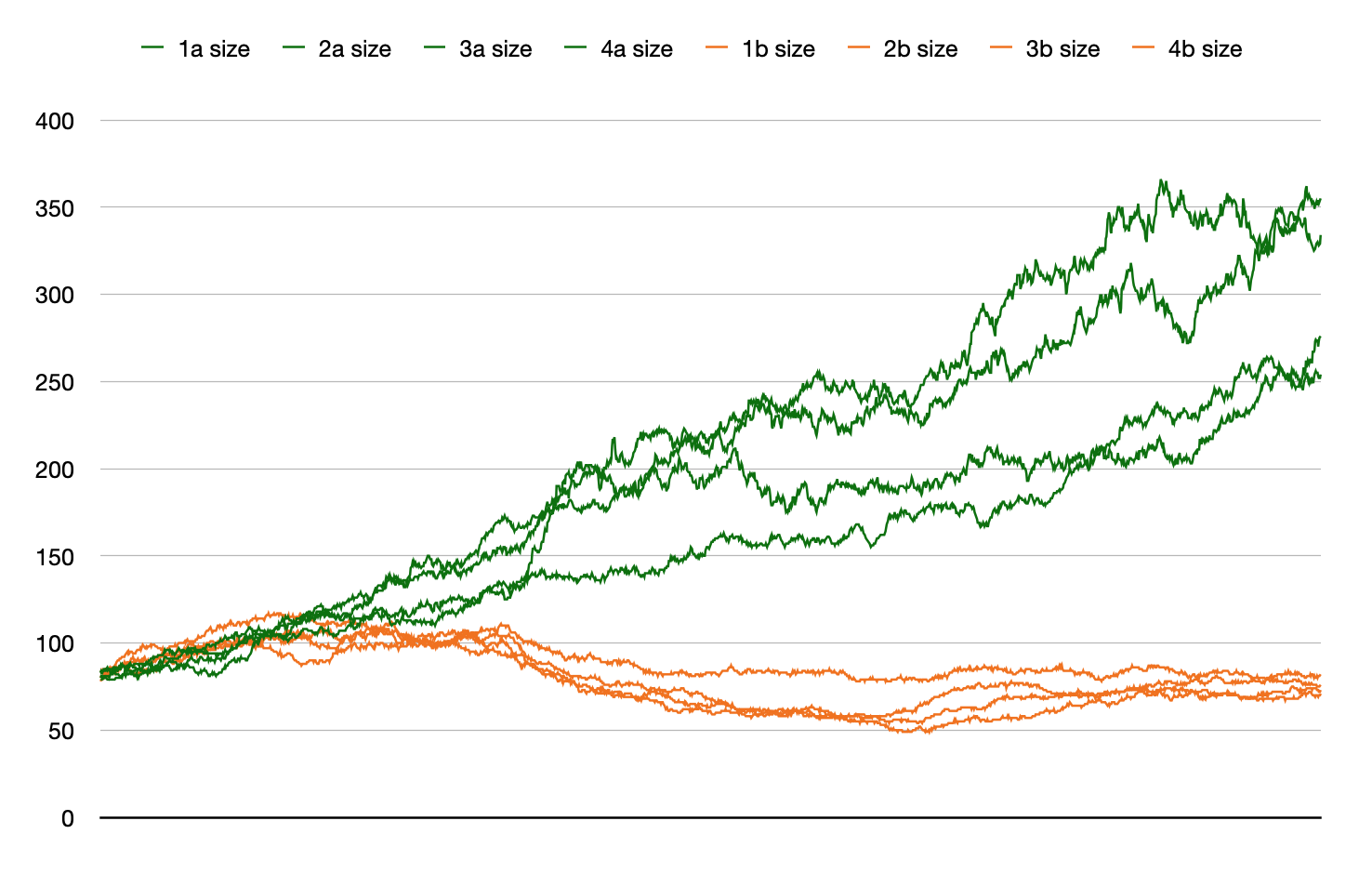
Here we zoom in on the bounded case (orange) to better see the
vertical scale. Not only are the allowed tree size values in a
narrow range, I also shifted this range twice during the run.
For the first ⅓ of the run, the size bounds are [100, 110]. So
if the parent tree is smaller than 100 (nodes) or bigger than
110, then size bias kicks in. For the second ⅓ of the run, the
size bounds are [40, 50]. For the final ⅓ of the run, the size
bounds are [70, 80].
The result is less crisp than I imagined. When (say) the upper
bound is crossed, the “offspring” is made to be smaller, but can
be much smaller. Perhaps with the upper and lower
bounds set so close (10 nodes) the bias was being used almost
each crossover, in opposite directions.
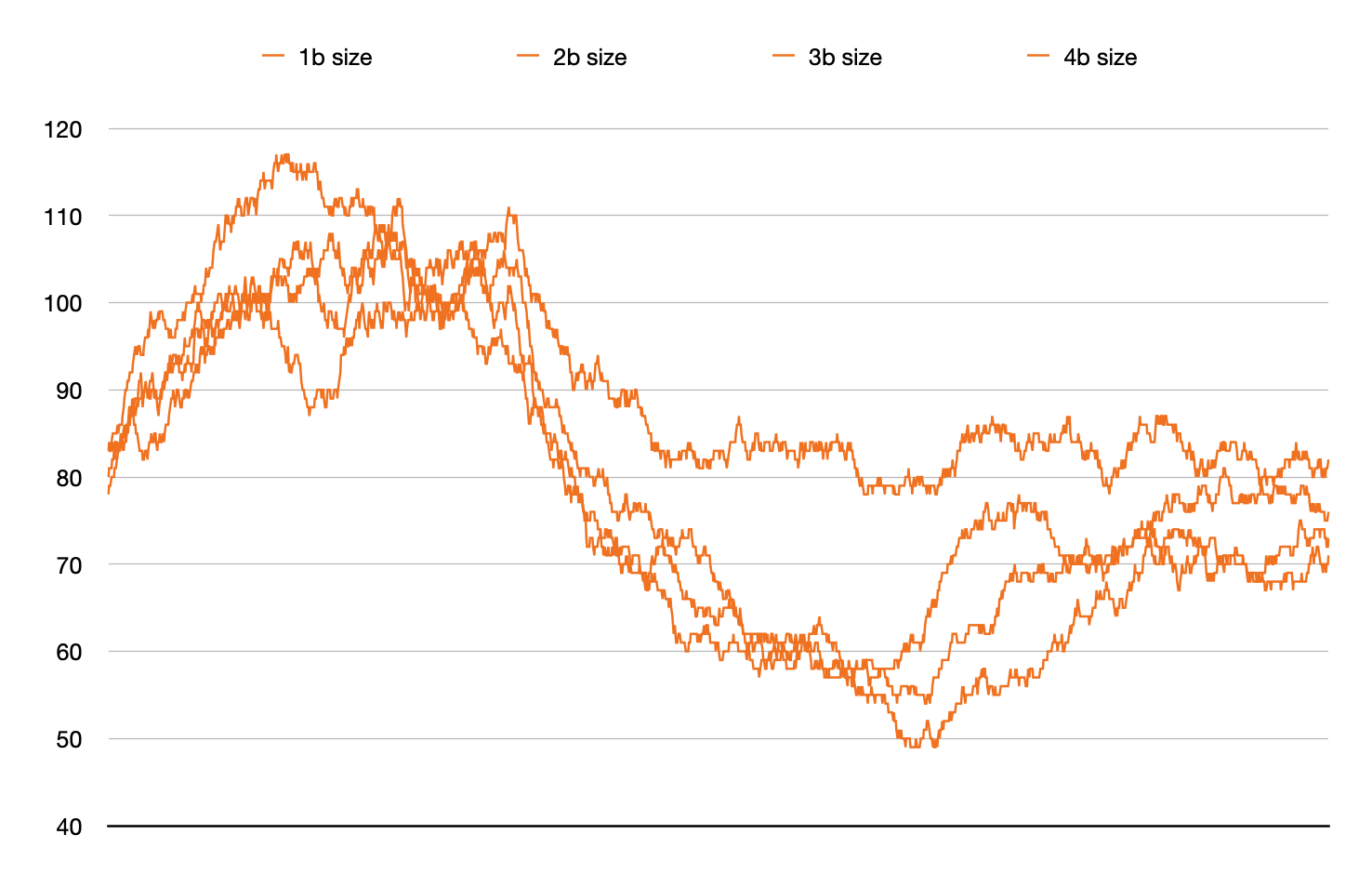
January
12, 2021
Size limitation during crossover: anti-bloat
As discussed on December 24, in some
genetic programming runs we see unbounded growth of program tree
sizes. This does not prevent the evolutionary optimization from
running, but is inconvenient because of slower execution,
potentially larger memory load, and the possibly of reducing the
power of crossover the make useful changes. (Since finding the
“right” place for crossover is harder in a large program).
This LimitHue::comparison() run was made with a
prototype change to the crossover code. Previously a parameter
to the construction of a Population has been
“maximum tree size” for the initial random GpTrees.
The new approach is to have a corresponding parameter for the
“maximum desired tree size” for crossover during the run. If the
“recipient parent” in a crossover operation has a size greater
than this threshold, the crossover operation will choose the
recipient subtree to be smaller than the donor subtree. As a
result, the new offspring GpTree will be smaller
(or in certain edge cases, the same size) than the recipient
parent. As a result, the Population is generally
constrained to be composed of GpTrees that
(generally) are smaller than the original “maximum desired tree
size” parameter.
In the current prototype implementation, this crossover limit
is 1.5 times the initial limit on random tree sizes. I will
probably provide API to set it directly. It also would make
sense to provide API for the corresponding minimum
size limit for crossover. This would mean that if the “recipient
parent” were too small, the crossover subtrees would be chosen
to increase the size of the offspring. I am not sure if this is
ever useful, but it seems like adding it now is better than
waiting to see.
While I do not want to read too much into an experiment with n=8
but it appears in this run that the four run with
the crossover size limitation (blue) have “best” and “average”
fitness slightly higher than the control case without
the limit (red):

In this plot of GpTree program size averaged over
all in a Population, we see a clear difference
between the four runs with the crossover size
limit (orange) and the control runs without
the crossover size limit (green). With the limit, all four runs
maintain average sizes below the limit of 150 while the four
runs without the limit reach size averages above 150 with one
reaching about 280:

January
5, 2021
Another day, another tweak, another ambiguous plot
I changed the choice of which subpopulation is selected on each
update step. It had been a random selection, now it simply
rotates through them in order. Probably no difference for large
runs, but in short test of 100 steps, I saw one (of four) get
about 30% of the updates. I also tested the migration policy and
added some other unit tests. This test is not obviously
different from the previous one, although one of the 4
subpopulation runs got up to 95% which I think is the highest
value I have seen. On the other hand, runs with 4 subpopulations
ended at 87.6%. Like the comparison run on January
3, it is hard to see any difference in performance between
using 1 (red) or 4 (blue) subpopulations.
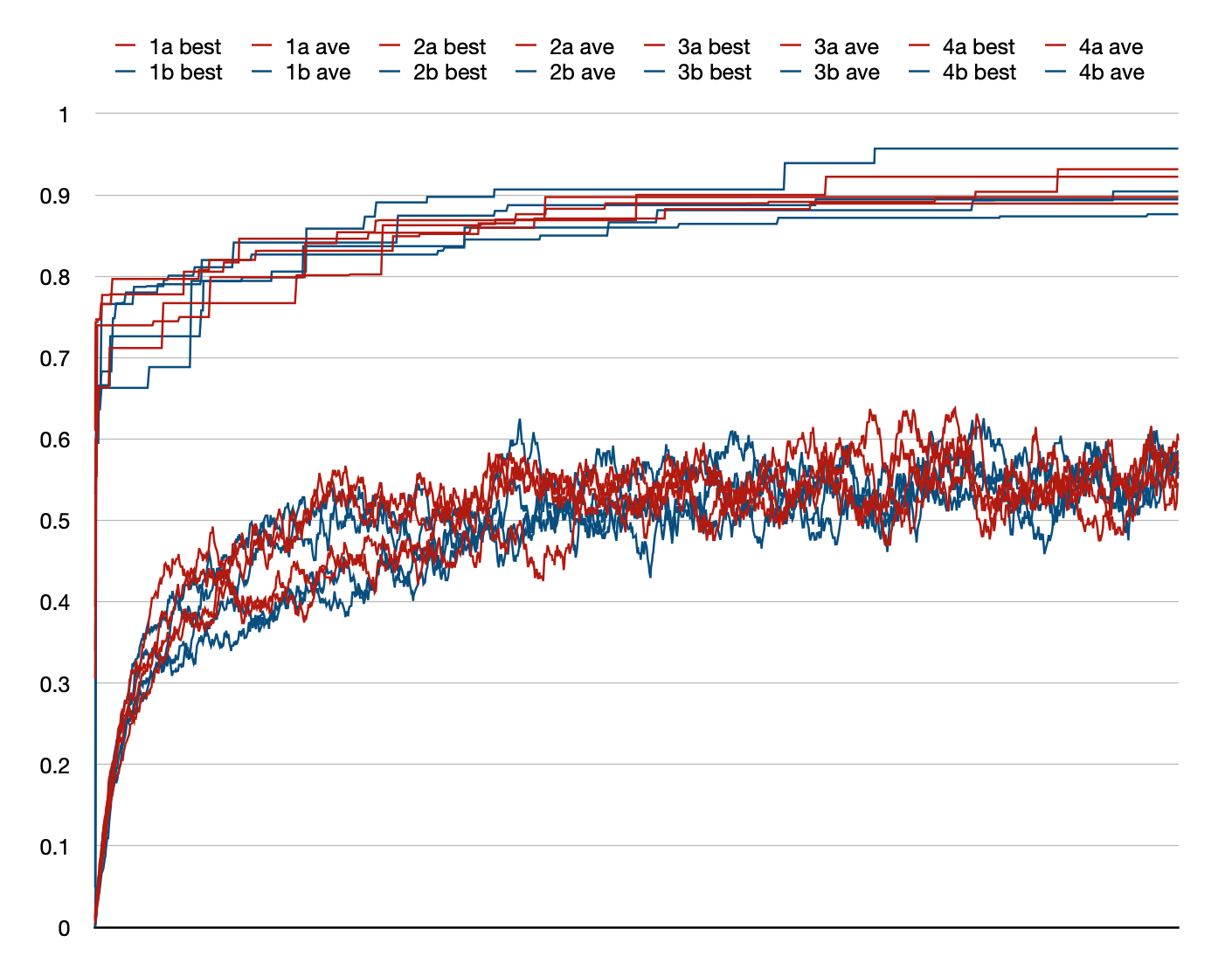
January
3, 2021
GP with subpopulations — “demes”
For a while now subpopulations had been on my to-do
list of features. This is the idea that instead of a population
with, say, 100 individuals, we divide them into four
subpopulations of 25 individuals each. The evolutionary
computation proceeds pretty much the same as before, except that
each Population::evolutionStep() starts by
selecting one of the subpopulations at random. Then as before,
it selects three individuals from that subpopulation, ranks them
by tournament, the two top ranked individuals produce an
offspring, which replaces the lowest ranked individual in the
subpopulation. In addition, individuals occasionally migrate
between subpopulations.
The notion is that running multiple populations in parallel
allows each of them to climb a different hill in fitness space,
allowing the population spread out its investment. Some of those
hills might be higher than others, so multiple populations
allows exploring more territory. Subpopulations are sometimes
called “demes” (“from the Greek” as James Rice, my early GP
mentor, told me when I asked about the term) as used in biology
“ a subdivision of a population consisting of closely related
plants, animals, or people, typically breeding mainly within the
group.” Similarly a single population GP, as LazyPredator had
been before now, is sometimes called “panmixia” from biology
meaning “random mating within a breeding population.”
I refactored Population to support subpopulation
and took it out for a test drive. I used the same LimitHue::comparison()
framework as before, making four pairs of runs, each run in a
pair starting from the same random seed, one run with a single
population, and one run with four subpopulations. Each run takes
2000 steps. I hoped for a clear fitness advantage for the
multiple subpopulation case. I did not find it. This plot is an
excellent illustration of the null hypothesis. The plots in red
have a single large population, those in blue have four
subpopulations ¼ as large. It would be hard to guess which was
which if they were not colored. Also puzzling is that the average
fitness for all eight populations are around 0.55 while
in previous runs they were near 0.75.
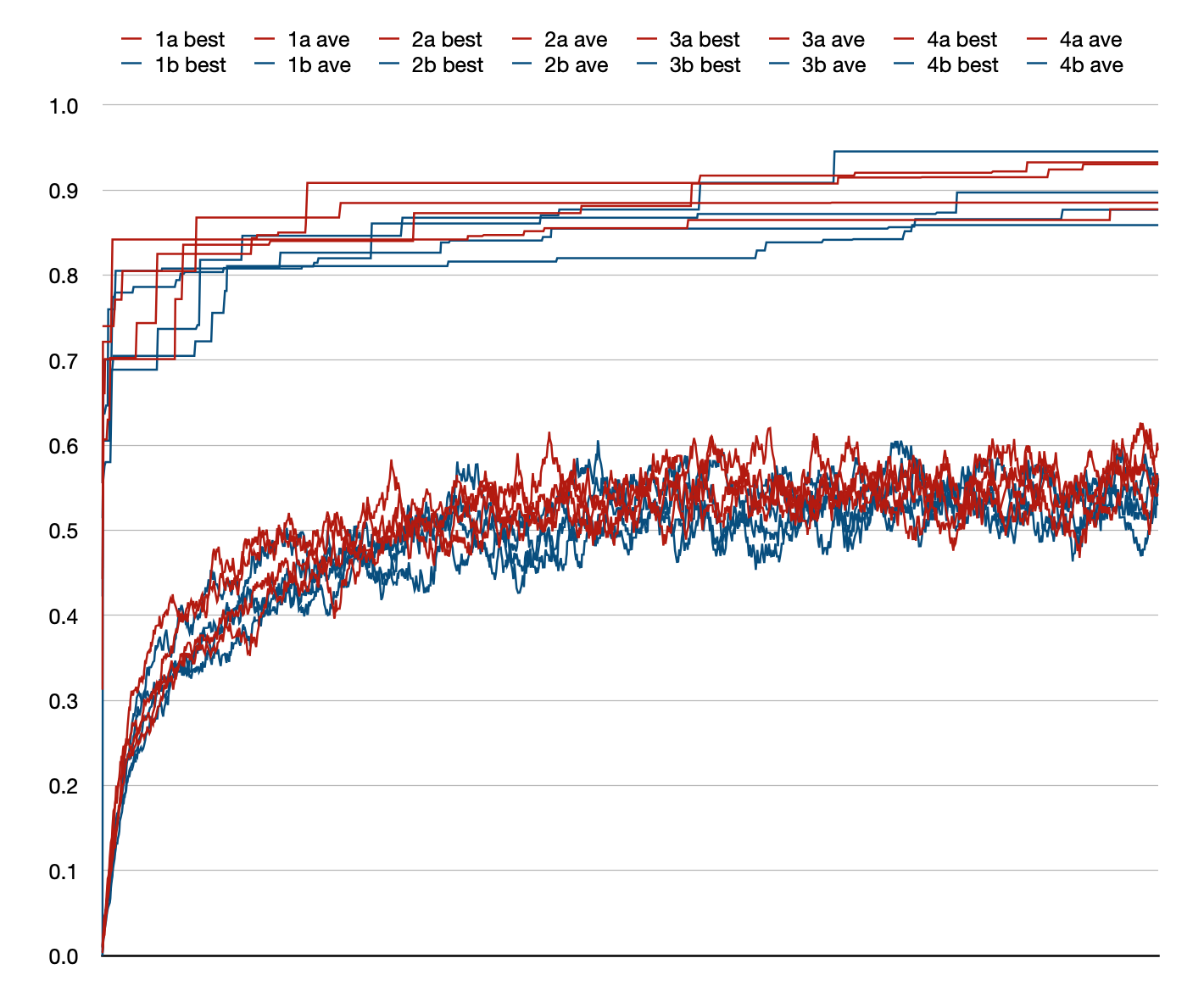
December
26, 2020
Oops, now computing initial “absolute fitness”
I had noticed, in TexSyn's prototype GUI, that right at the
start of a run, some of the “top ten” fitness textures listed
fitness of zero, which seemed incorrect. (That is, it “looked
like” they ought to have higher fitness.) I first assumed this
was just a bug in the GUI, but looking closer, it seemed to be a
real bug. In the original tournament-based relative
fitness approach, a relative fitness ranking is determined each
evolution step (Population update) for the three
randomly chosen Individuals. This was not
happening for the later prototype absolute fitness.
The runs plotted below are like those on December
23 but an initial pass is made over the Population
computing initial fitness for all Individuals. It
may be just random variation between runs, but it looks like
there is now generally less variance between runs, and that the
best of the best are a bit higher. The overall best is 0.924 in
run 3a.
I will fold this change into refactoring absolute fitness
to be a layer on top of tournament-based relative fitness.
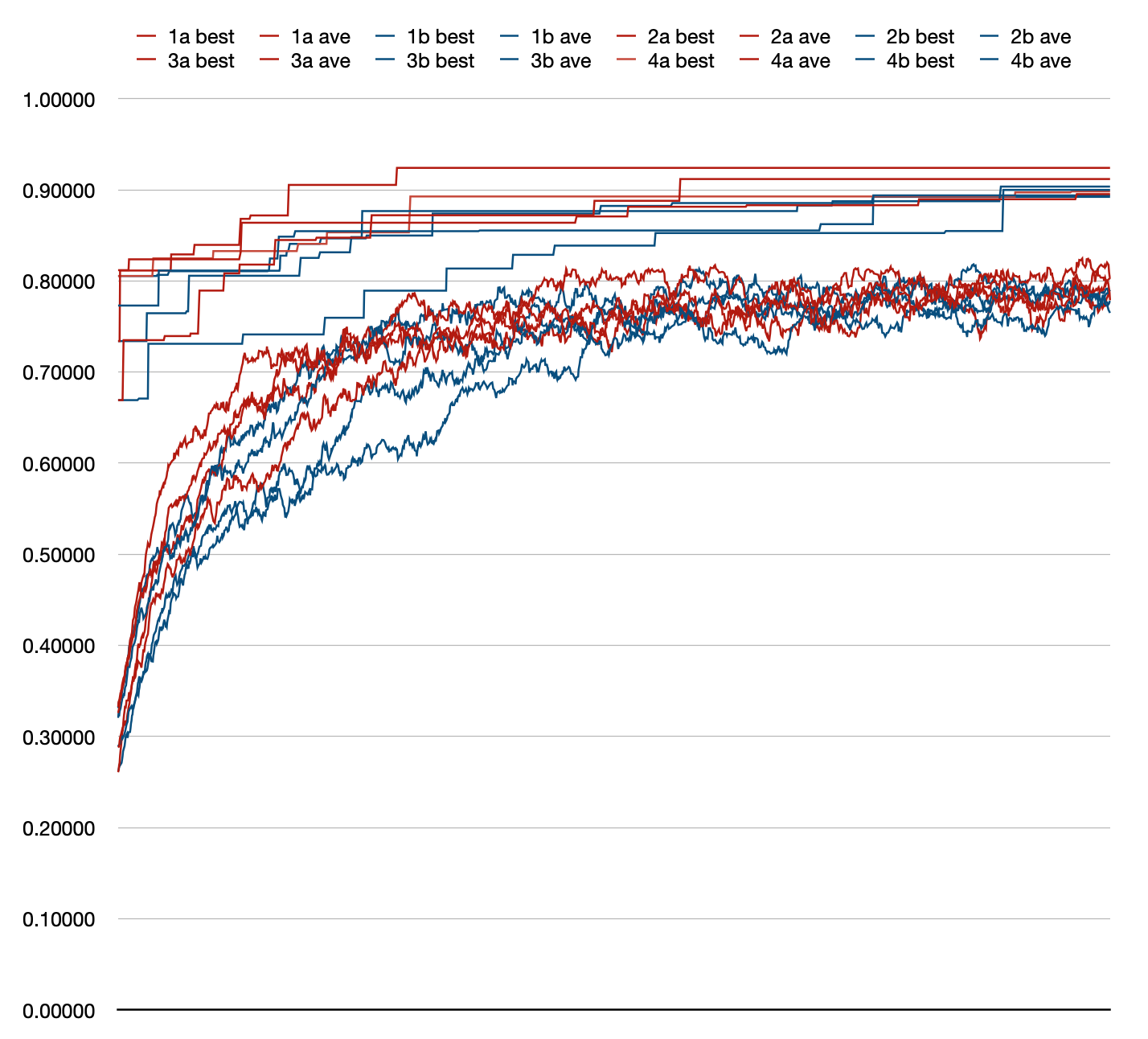
December
24, 2020 🎄
Tree size and bloat
Speaking of data from those LimitHue::comparison()
runs, I also recorded average-of-population tree size for each
evolution step. Recall each run was initialized with 100
individuals, each with a maximum initial tree size of 100.
(Tree size is equivalent to the number of function names and
constant leaf values in the corresponding textual program
notation. An interesting tidbit is that all runs start with an
average tree size very close to 80. This ratio between average
and maximum tree size (e.g. 80/100) probably depends on the FunctionSet
being used.)
Most of the average-of-population sizes seem to end up between
200 and 400. While the first of these eight runs—the black trace
in this plot—wandered into the land of giant trees, peaking up
near size 1100. This occasional misbehavior of GP systems is
called bloat. Tree size does not directly
correlate with execution time, via GpTree::eval(),
since some GpFunctions may run slower than others.
But it is a safe bet that, in general, a big tree will be slower
than a small tree. Larger programs certainly take up more
memory, but in my applications that is not a issue. There is
also a theory, a GP “folk belief”, that large trees can dilute
the effectiveness of crossover.
I have a design sketched out that I hope will allow controlling
tree size to avoid bloat in what I think is a fairly natural way
that will not interfere with fitness measurement.
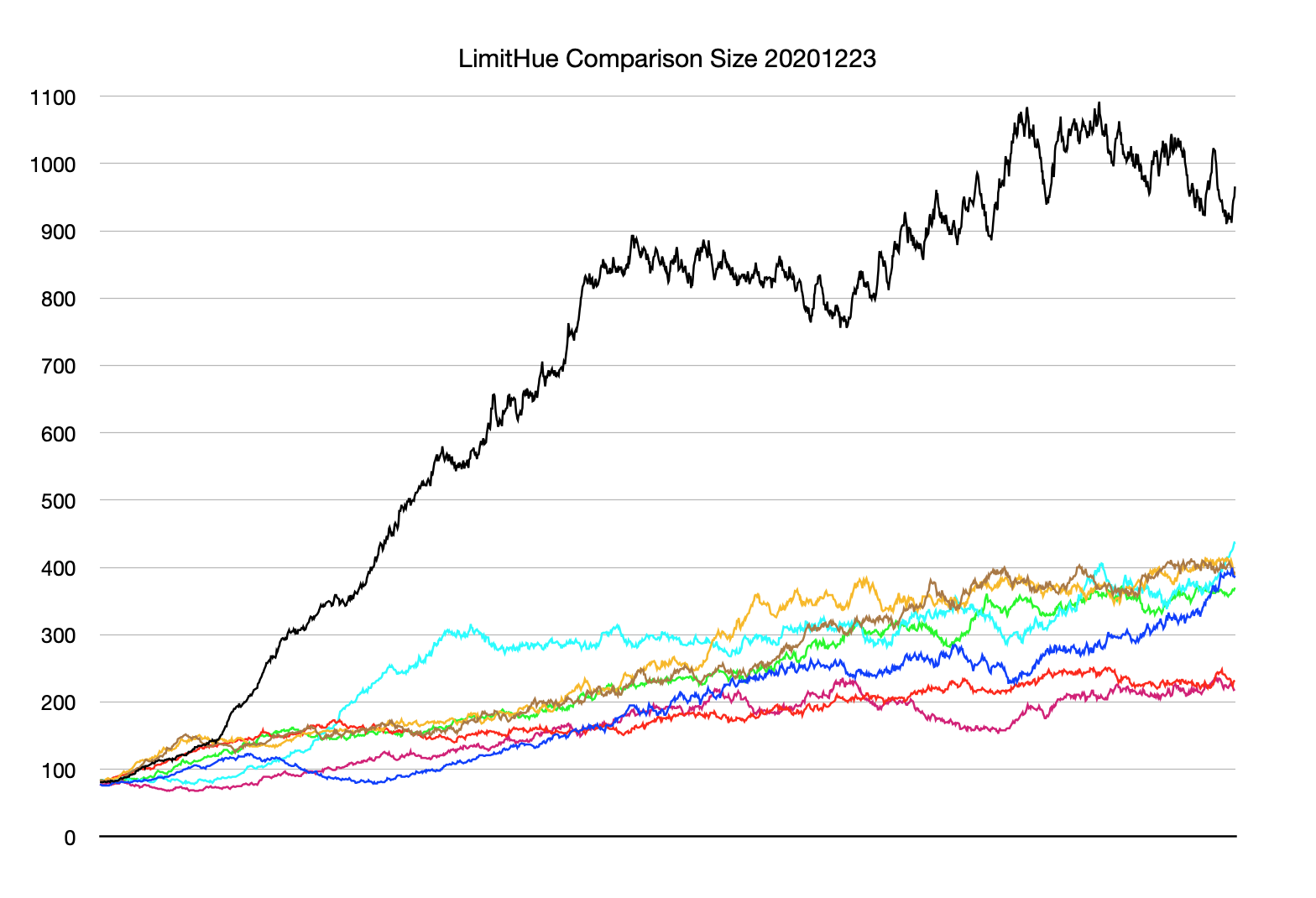
December
23, 2020
Redefine “absolute fitness” on top of relative tournaments
As discussed in the TexSyn blog on November
18, I went off on a side quest related to “absolute”
fitness. This is the more common way of thinking about
evolutionary computation, where an individual is tested or rated
according to a fitness function, resulting in a numeric value.
The goal of the optimization is then to maximize this fitness
(or minimize, if you consider it an error or loss
metric). LazyPredator is meant to deal primarily with “relative”
fitness, as determined by competitive tournaments. (Recall the
analogy: while speculative ratings can be assigned a priori
to (say) athletes, it is not until they compete in a tournament
that a winner is actually determined.)
However, based on what seemed like lackluster optimization
based on tournaments, as a basis of comparison, I set off to
re-implement the traditional evolutionary optimization, as I had
done in earlier work. So instead of using tournament-based
contests, I added a parallel facility for absolute numeric
fitness, judging Individuals in isolation. The
tournament-based evolution step looked like:
- Randomly select (with uniform distribution) three
Individuals
from the Population.
- Place them in a competitive tournament to produce a fitness
ranking.
- The first and second place finishers are selected as
“parents.”
- Use crossover and mutation to produce a
new “offspring” from the parents.
- The third place finisher is removed from the population
(“dies”) and replaced with the offspring.
The more traditional “absolute fitness” based evolution step
was:
- Randomly select two parents from the population biased
toward high fitness.
- This was done by making a uniform selection of three
individuals then choosing the one with highest fitness.
- Randomly select one individual from the population, biased
toward low fitness, to be replaced by the new offspring.
- This was done by making a uniform selection of three
individuals then choosing the one with lowest fitness.
- Use crossover and mutation to produce a
new “offspring” from the parents.
- Replace the low fitness individual with the new offspring.
Note that absolute fitness for a given individual does not
change, so is computed one per individual then cached. This is
generally not the case for competitive fitness.
I got to thinking about the selection procedure. In the
absolute case, nine individuals are selected then used as bias
to winnow down to the three actually used in the update step. I
wondered if this level of “elitism” was good or bad. Parents
would always be selected from the top ranked individuals in the
population, because the best-of-three selection is strongly
biased toward them. Conversely, all the “deaths” would be among
the the very low ranked individuals. This sort of elitism may
cause the evolutionary optimization to be “greedy” — to
concentrate on low hanging fruit — and perhaps be short-sighted.
So I considered a different selection procedure: uniformly
select three, rank those as in the competitive tournament case,
the top two are the parents, and the “loser” is replaced by the
new offspring. That is, the absolute fitness case is implemented
as a simplistic tournament where rankings are
just sorting by fitness. Unlike the nine-way selection, it is
possible that all three participants (two parents, and loser)
could be from the very bottom, or the very top, of the rankings.
I set up a comparison framework to run four rounds of both
conditions (both beginning from the same random seed). Each
Population consisted of 100 Individuals, each with a maximum
initial size of 100. Each optimization was for for 2000 steps
(which is 20 “generation equivalents”). The entire comparison of
eight runs took abut 5.5 hours.
For each run, I recorded the fitness as best-of-population and
average-of-population, for each of the 2000 steps. These are
shown in the plot below. There are 16 lines, best and average
for each of eight runs. They are color coded by condition: (a)
the nine-way selection with stronger bias are in the
magenta-to-red range, (b) the three-way selection with less bias
are in the green-to-cyan range. The “best” at the top are
monotone increasing steps, the “ave” plots are lower and noisy.
After all that, what I see in the plot is no obvious
difference in performance between the a/red runs and
the b/green runs. The best-of-population fitnesses end up around
0.85 to 0.90, with the averages around 0.75. The averages
of the b/green runs are closer together, possibly indicating
less variance, but that is just a supposition.
I will take all this as evidence that LazyPredator's support
for “absolute fitness” should be refactored to be based on top
of tournament-style evolution steps.

November
27, 2020 🍗
GpTree with “phantom limb”
Toward the end of November I was tracking down a memory leak.
As described here,
the leak was actually in OpenCV. It took me a while to track
that down because of an unrelated “confounding bug” in TexSyn's
FunctionSet defined in GP.h. The
actual code, a GpFunction initializer, is shown
here, with the bug in red:
...
{
"CotsMap",
"Texture",
{"Vec2", "Vec2", "Vec2", "Vec2", "Texture", "Texture"},
evalTexture(CotsMap(argVec2(),
argVec2(),
argVec2(),
argVec2(),
argTexture()))
}
...
The problem is that the third line has a typo, an extra GpType
specification for a Texture. It is saying that the
GpFunction for CotsMap has six
parameters: four of GpType Vec2 and
two of Texture. In fact, as seen
in the next line, CotsMap actually has five
parameters, four Vec2 and one Texture.
The result of this specification mismatch is that any occurrence
of CotsMap in a GpTree would
generate six subtrees. One of them would be
ignored, specifically by GpTree::eval(), leading
to uninitialized values, which caused an error in the
destructor. This mismatch caused no end of confusion, especially
appearing as it did during my hunt for the memory leak.
To avoid this confusion in the future I need a way to validate
that these two different ways of specifying the parameters to a
GpFunction match. One side has to do with actual
C++ code definitions and one has to do with the abstractions
used by FunctionSet. The lack of “introspection”
in C++ makes this difficult. For example it would be
straightforward in Lisp.
October
31, 2020 🎃
Progress report: TournamentGroup and bug fix
I have been working along, making incremental progress. After
the “yellow/green” test described on October
19 I started on a slightly more ambitious test case I
called “colorful, well exposed” textures (in a package named CWE).
It is nearly random evolution, constrained only by
tournament-based “fitness” tests that favor textures with a full
range of brightness (luminance) and color saturations. It
measures these by uniformly sampling colors from the texture,
placing them into a histogram (of saturation or brightness) then
scoring the histogram's flatness (uniformity).
Previously, a lot of my prototype tournament functions had the
structure of passing in three Individual* pointers
and returning the “worst” one, the loser of the tournament. This
felt awkward and led to duplicated code (e.g. for finding best
or worst individuals). So I refactored things to put most of
that into a new class TournamentGroup. It
encapsulates the previously duplicated code and serves as a
container for the individuals in a tournament, with the side
benefit of allowing them to have arbitrary size. (In case there
is ever a need for tournaments with 2 or 10 participants.)
Always the careful incrementalist, I made an #ifdef
flag so converting to using the new class was reversible. I got
the CWE test running with TournamentGroup
then went back to verify I got the same result from the old and
new code. I did not. While poking around I
realized that the old code had a significant bug in Population::evolutionStep().
It was related to that “duplicated code” issue, and was
definitely doing the wrong thing in ⅓ of the cases.
After various testing, I went back to the YG
(“yellow/green”) test and reran it, using the new TournamentGroup-based
bug-free code and got much more satisfying results. The October 19 results seemed disappointingly
“indecisive.” I had expected the green level to push right up
toward 100% and the blue level to drop down near zero. Instead
the results less convincing—green was highest, red in the
middle, and blue lowest—but they wandered in the mid-range
instead of pushing out to the bounds. I plotted the results of
the new run and it looked much better. Not only are the
“population best” green/blue values very close to the bounds,
but the “population average” are within about 5% of the bounds.
Also this run is 1000 evolution steps long. The run on October
19 was five times longer and never got this close to its goal.
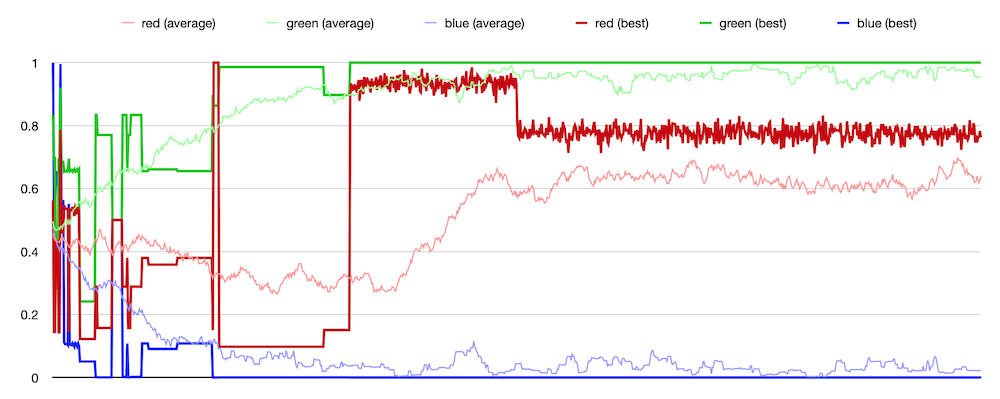
October
19, 2020
Evolution: first quantitative data
I did some more tooling work, and collected some data on the
simple test application I described on October
17. As then, there are 3-way tournaments. Three TexSyn
textures compete based on their “average color.” That is, as if
they were infinitely blurred, and could be represented by a
single color in RGB space. The tournaments have two cases, one
of which is selected randomly. The three textures compete for
either (a) the highest green component of their three average
colors, or (b) the lowest blue component. This should drive the
population toward colors with high green, low blue, and
unconstrained red. This describes colors in the yellow-to-green
region.
The run plotted below has a population size of 50, and was run
for 5000 steps (which corresponds to 100 “generation
equivalents”). This took about 20 minutes, or longer if I
rendered the textures. Originally I displayed them one after
another, as sort of a flickering movie, which allowed me to see
they were trending toward yellow/green color schemes. I recorded
ad hoc data and made some plots. I looked at the
“average average” color—taking the average color of all 50
textures in the population and averaging them together each
step. That produces the wiggly lines in the plot below
identified in the legend as “red (average)” etc. This looked OK,
the green was higher, blue lower, and red seemed to drift
someone in between. Then I selected one member of the population
as “best.” This is subject to change. My current criteria for
“best” is the member of the population which has “survived” the
most tournaments. Since losing a tournament (being ranked third
of three) leads to an individual being removed from the
population, it seems that the number of times one has been
tested and survived is some proxy of quality. The three
step-like plots show this current “best” individual's average
red, green and blue. The step changes are when a new best comes
along, then holds steady until the next change of rankings.
Unlike the “average average” plots, these “best” values are
closer to the extremes, near or at the bounds of unit RGB space.
(TexSyn does not place bounds on color values, but I used Color::clipToUnitRGB()
when computing average colors for this run.)
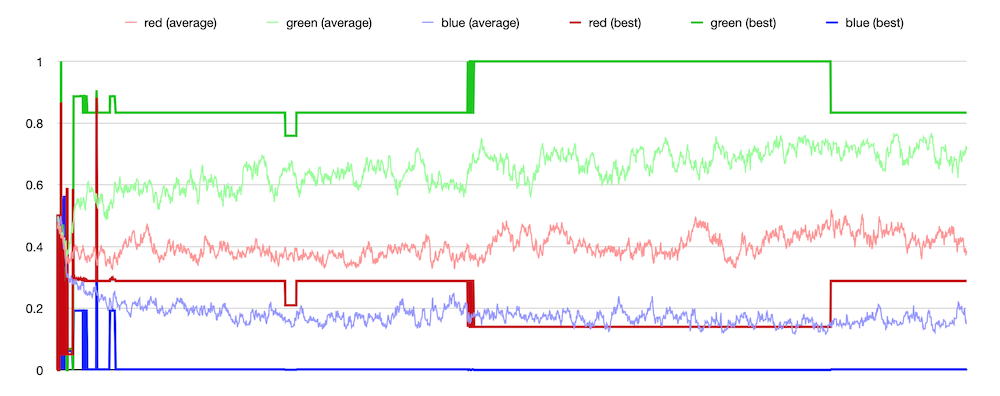
One unrelated problem that arose during this work had to do
with “minimum size for crossover snippet” as discussed on October 8. On a whim I had chosen a value
of five, while the smallest valid TexSyn tree
has size four, as in: Uniform(0.3, 0.8,
0.4). My thought was I would rather see slightly larger
subtrees used for crossover. It seemed to work fine until today
when I was initializing a larger population of size 50. One of
those initial random trees just happened to be that minimal size
four example.That led to an obscure divide by zero error. I made
a temp fix but it needs some more thought.
October
18, 2020
Fixing that mutation problem, setting jiggle scale.
I re-enabled GpTree::mutate() and tracked down
the problem seen earlier. The
added-in-a-hurry GpType::getMaxJiggleFactor()
function was misbehaving (the wrong this pointer
was captured in the jiggle handler lambda). The intent was to
allow customizing the “jiggle scale” but as I had noted in the
code, it was not obvious how or when that could happen. I
suspect it does not really matter. The default value (of up to
±5% of the given numeric range of a GpType) would
probably be fine. But if some imaginary future user of
LazyPredator did need to tweak that value they would
be annoyed it was not settable.
So instead, the mutation bug is now fixed, and the “jiggle
scale” still defaults to 0.05 via a new static function called GpType::defaultJiggleScale(),
but can be overridden by yet another constructor for the class.
For example one of the TexSyn GpTypes is currently
written:
...
{ "Float_01", 0.0f, 1.0f },
...
with its “jiggle scale” defaulting to ±5%, or a
custom value can be given like this:
...
{ "Float_01", 0.0f, 1.0f, 0.2f },
...
indicating the jiggle scale for that type is ±20% of the given
range [0, 1]. Shown below is a plot of repeated jiggle mutations
of values from two such GpType definitions. The
blue trace corresponds to the default jiggle scale of 0.05 and
the red trace with a scale of 0.2. The red trace can change by
four times the amount of the blue trace—per mutation—so moves
four times faster. There are 500 steps across the horizontal
axis.
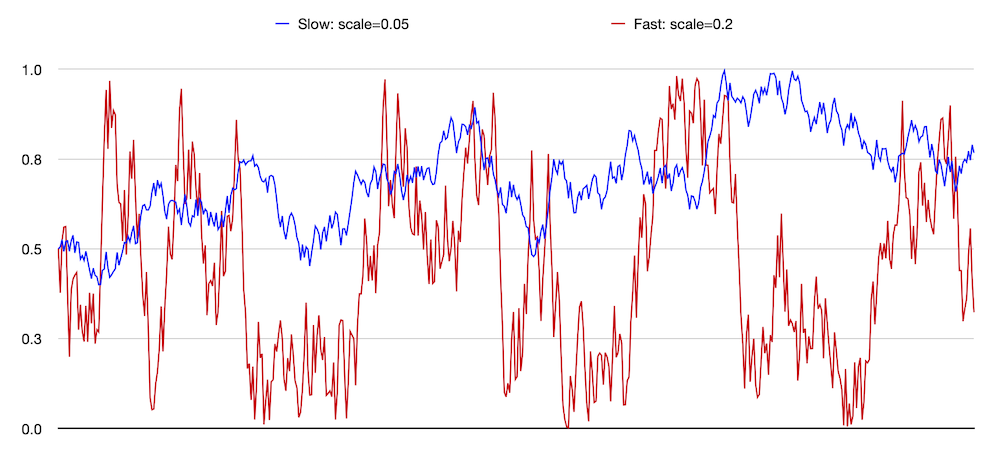
October
17, 2020
Evolution, almost certainly!
Huzzah! On October 15
I cobbled together a minimal evolution run, using the TexSyn
API. I ran a small number of “steps” — steady state population
updates — and it did not crash. The next day I cleaned up the
prototype tournament function so it might actually be correct.
Then I tried a longer run. I got to step 61 when it failed an
assert (in TexSyn's RGB↔︎HSV conversions). That code has been
stable for many months, as I dug in it seemed to just be
noticing bad input data (floating point nans).
Then followed a lot of unsuccessful attempts to isolate the
failure. Finally I recalled that I had slapped together GpTree::mutate()
just before trying an evolution run. Indeed, when I commented
out the call to that, the assert failures stopped. To be fixed
soon.
Even better, when I let my tiny Population of 10
Individuals run for 1000 steps — what my
non-steady-state peeps would call “100 generations” — the Population
seemed to be clearly evolving toward the goal state. As
mentioned in the previous post, I was looking only the “average
color” of the TexSyn Texture which is the value of
the evolving Individuals. In fact, I looked only
at the green and blue components of the average color (in RGB
space) so all details of textures are ignored. The “winners” of
a tournament among three Textures are the two
whose average color have either: the higher green level, or the
lower blue level. (Conversely: the “loser” of the tournament is
the color with the lowest green or highest blue.) This is a
simplistic example of a 3-way tournament and multi-objective
optimization. Participants in the tournament are chosen at
random, uniformly across the Population. The
tournament then makes a uniform random choice between minimizing
blue or maximizing green. As the 1000 step evolution ran, the
tournament-winning texture clearly moved into the
green-to-yellow color range. (The red RGB component is ignored,
so allows drift across the green-yellow range.)
There is lots more to do, but at least LazyPredator has passed
into “not obviously broken” territory. I noticed that the modest
1000 step run accumulated 1.8 GB of memory which means it's
leaking memory like mad. OpenCV Mat objects are a
likely candidate.
October
15, 2020
Evolution, maybe?
I think I got all the pieces glued together sufficiently so
this afternoon I was able to “turn the crank” on an evolutionary
computation, if only briefly. It is at least running. Not sure
if it is actually working. The first version was using random
tournaments, so it was impossible to tell. Then I tried to make
a simplistic tournament function. Using the TexSyn FunctionSet,
I told it to prefer textures whose average color had high levels
of green or low levels of blue. This should produce textures
which are primarily in the green-to-yellow neighborhood of color
space. Again, it ran OK, but no obvious evolutionary change in
such a short test.
October
14, 2020
Back to Population and Individual
After about two months developing a representation for genetic
programming (FunctionSet, GpTree, GpFunction,
and GpType) I have returned to the basics of
evolutionary computation: Individual and Population.
My initial plan is to avoid the traditional numeric measure of
fitness, instead using relative fitness as measured in
competitive tournaments. For some definitions of fitness, there
is no significant difference. If we define the fitness of a
tower as its height, then that one number tells us all we need
to know about an individual. But in other kinds of fitness—for
example, which team in a sports league is best—all that can be
established is a relative ranking. We cannot evaluate a team to
produce a single numeric fitness that predicts which of two
teams will win a match.
My initial plan is to use tournaments of three Individuals
from the Population. This provides a minimalist
replacement strategy for the “steady state genetic algorithm”:
three individuals are selected at random (neutral selection, not
“fitness proportionate”), they compete in a three-way contest,
the Individual which does the worst is removed
from the Population, and replaced with a new
offspring, formed by crossover between the other two Individuals
in the tournament. It is not required to establish a “full
ordering” of the three Individuals, only to
determine which is in last place. The ranking of the other two
is ignored.
Yesterday I experimented with several implementations of Population::selectThreeIndices()
to select three random but unique (“without replacement”?)
members of the population to be in a tournament. (The “modern c++17
way” of doing this is with std::sample() but for
the moment I needed to use LP's RandomSequence
API.) Today I started building out the Individual
and Population classes. I am now able to
initialize a Population of a given size, where each Individual
is initialized with random GpTree of a given max
size from a given FunctionSet.
October
11, 2020
“Jiggle” mutation for numeric leaf values.
Based on yesterday's streamlining for
ranged numeric types, it was pretty easy to add a new handler
function to GpType to provide “jiggle” mutation
for the numeric constant values found at leaves of GpTrees.
Like yesterday, I only supported c++ concrete types int
and float. If others are needed they can be added
later, or explicitly implemented using the older, more general
form of GpType constructor. The jiggle handler
function is automatically constructed for a ranged numeric
GpType, based on the given range bounds and a parameter
prototyped as GpType::getMaxJiggleFactor(). It is
currently set to 0.05 so at any given jiggle, a value will be
offset by up to ±5% of the given range. Here is a
little test code to watch iterated jiggle of an int
and float type on the range [0, 100]:
GpType ti("Int", 0, 100);
GpType tf("Float", 0.0f, 100.0f);
std::any vi = 50;
std::any vf = 50.0f;
for (int k = 0; k < 1000; k++)
{
vi = ti.jiggleConstant(vi);
vf = tf.jiggleConstant(vf);
std::cout << ti.to_string(vi) << ", ";
std::cout << tf.to_string(vf) << std::endl;
}
The result behaves as a “bounded Brownian” series. It stays
within the given range, covering the entire range, while not
hugging the bounds due to clipping. I took the log from that
code and pasted it into a speadsheet for plotting:
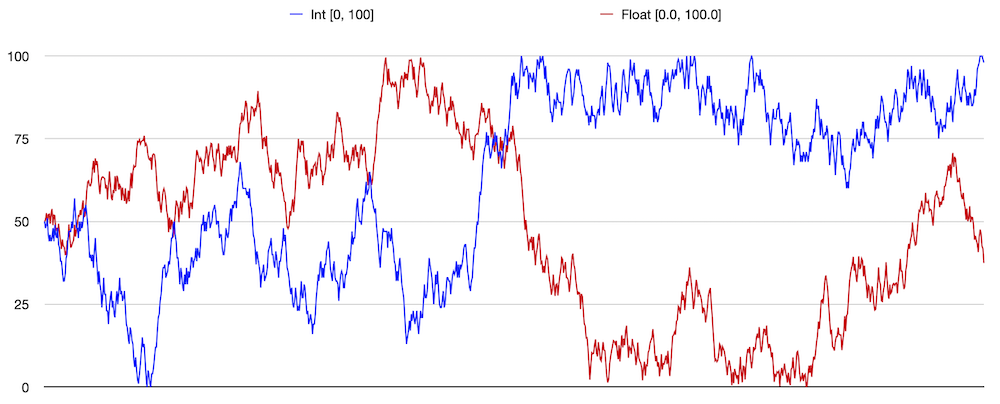
October
10, 2020
GpType constructors: less is more
Two key operators in genetic programming are crossover
and mutation. Crossover has been discussed before. I was starting to think about a
“point mutation” operator on GpTrees that adds
noise to numeric parameters in a tree's leaves. This is not
about that, but was prompted by setting the stage for it. The
definition of TexSyn's FunctionSet consists of two
collection: GpTypes and GpFunctions.
(And now a third parameter for crossover_min_size.)
Before today, the GpType specs looked like this:
{
{ "Texture" },
{ "Vec2" },
{
"Float_01",
[](){ return std::any(LPRS().frandom01()); },
any_to_string<float>
},
{
"Float_02",
[](){ return std::any(LPRS().frandom2(0, 2)); },
any_to_string<float>
},
{
"Float_0_10",
[](){ return std::any(LPRS().frandom2(0, 10)); },
any_to_string<float>
},
{
"Float_m5p5",
[](){ return std::any(LPRS().frandom2(-5, 5)); },
any_to_string<float>
}
}
I have been glossing over this format for GpType
constructors, since it felt a little preliminary. Texture
and Vec2 are used only as tags to correctly
matching up inputs and outputs of GpFunctions. The
other four types are specializations of the concrete c++
type float. These four types differ only in the
range of values they represent. For example, Float_01
are values on the interval [0.0, 1.0] and Float_m5p5
are values on the interval [-5.0, 5.0]. For each GpType
“initializer list” (between braces {}) there is:
(1) a character string name, (2) a function to return a random
“ephemeral constant” uniformly selected from the type's range,
and (3) a function that casts from a value of this type to a
character string for printing. (The values actually passed
around are of type std::any for “type erasure” but
let's not get into that right now.)
I came up with a way to make this less messy. I hope eventually
that LazyPredator will be used for other applications. For now
however, it is only being used with the FunctionSet
for TexSyn. So this may be short-sighted, but so far, a GpType
either just tags an instance of a c++ class (like Texture
and Vec2) or it represents a numeric type, perhaps
with range constraints (like Float_01 ... Float_m5p5).
So rather than writing out the two (soon to be three) handler
functions/lambdas, all we need to specify are the ranges. I
defined two new constructors for GpType one for
float and one for int that takes: a name, range_min, and
range_max. The internal structure of a GpType
object is unchanged, this is just a different way to initialize
its internal state. The result is a much more compact
specification for the GpTypes of a FunctionSet:
{
{ "Texture" },
{ "Vec2" },
{ "Float_01", 0.0f, 1.0f },
{ "Float_02", 0.0f, 2.0f },
{ "Float_0_10", 0.0f, 10.0f },
{ "Float_m5p5", -5.0f, 5.0f }
}
I like this approach. The connection with mutation operators is
that soon there would have been need for a fourth item in GpType's
initializer list: a function to “jiggle” an existing value of
this type. Having defined a GpType as a ranged
numeric value, we can automatically generate the handlers for
randomizing, printing, and soon, for mutating. The older
constructors remain available for cases not covered by this
streamlining.
October
8, 2020
Minimum size for crossover snippet
I am developing LazyPredator and TexSyn in parallel, so
sometimes its hard to decide which “blog” should get a post.
Recent work with GP crossover was been reported in TexSyn's
posts on October 3
and October
5 (and previously on this page on September
30). The topic of the October 5
post, and this one, is the question of whether random “crossover
points” in a pair of parent GP trees should be selected
uniformly across all nodes in the trees. I think this is the
most common and “traditional” approach. But I decided to allow a
variation on this which seems useful in a concrete case like
TexSyn's FunctionSet.
The GP tree crossover operation is based on selecting, in two
“parent” trees, a pair of nodes. Those two nodes are the roots
of two subtrees, which can be thought of as a snippet of code in
normal linear textual code notation. We copy the selected
subtree of the “donor” tree, and paste it over the subtree of
the “recipient”/offspring tree.
But let's back up a bit, how is the random selection of a node
in each tree defined? In the October 3
examples this was done in what I consider the “traditional” way:
a recursive traversal of the tree is made and a reference to
each node/subtree is stored in an array (in this case an std::vector),
then a random index over the size of the array is generated and
the corresponding subtree is selected. (Equivalently without the
array: one traversal measures the size of the tree, the random
index is determined, then a second traversal is made until it
reaches the node corresponding to that index, which is
returned.) This means that the selection of tree nodes is
uniformly distributed over all nodes in the tree.
Because LazyPredator is based on STGP (strongly typed genetic
programming) there is an additional constraint that the two
selected subtrees have the same type (GpType). This
is accomplished by first selecting a node in the “donor” tree,
then filtering the nodes of the “recipient” tree to consider
only subtrees with a matching type.
Consider this (partially redacted) FunctionSet.
It shares a property with TexSyn that the root type (Thing)
has no “ephemeral constants”, while the other type (Int)
has no operators, appearing only as numeric constant leaf nodes:
FunctionSet fs =
{
{
{
"Thing", nullptr, any_to_string<...>
},
{
"Int", [](){ return std::any(int(LPRS().randomN(10))); }, any_to_string<int>
}
},
{
{
"This", "Thing", {"Thing", "Thing"}, [](const GpTree& t) { ... }
},
{
"That", "Thing", {"Thing", "Thing"}, ](const GpTree& t) { ... }
},
{
"Other", "Thing", {"Int", "Int"}, [](const GpTree& t) { ... }
}
}
};
This is a typical random GpTree, of size 55,
created by that FunctionSet with 28 numeric
constant leaf nodes (in red):
This(Other(9, 0),
That(This(This(This(Other(8, 2),
This(Other(5, 9),
Other(3, 8))),
Other(3, 1)),
That(This(This(Other(6, 1),
Other(8, 1)),
Other(4, 0)),
This(Other(3, 2),
That(This(Other(9, 4),
Other(6, 9)),
This(Other(6, 4),
Other(1, 9)))))),
Other(9, 6)))
Note that 28/55 or about 51% of random nodes (selected
uniformly) will be these numeric constants. So given two GpTrees
from this FunctionSet, roughly half of all
crossover operations will consist of moving a single numeric
constant from one tree to the other. (Recall that in STGP, Ints
from one tree can only crossover to Ints in the
other tree.) About half the crossover operations will do nothing
but parameter “tweaking” and in a way that ignores the context
that would normally exist when a larger subtree is moved. I
would prefer that “tweaking” constant leaf values be done by
point mutation, which is defined to make “small” changes in
value.
Consider instead this version of that FunctionSet, identical
but with the new crossover_min_size parameter
added at the bottom:
FunctionSet fs =
{
{
...
},
{
...
},
2
};
By increasing the crossover_min_size to 2
from its default of 1, this requires that all
crossover subtrees/snippets must be of size 2
or larger. Specifically this means that a single numeric
constant leaf value (of size 1) is excluded
from selection as the crossover subtree/snippet. (As mentioned
above, this is accomplished by filtering the set of candidate
subtrees, in this case by size.) The effect of this is that all
crossover snippets must consist of subtrees larger than a single
leaf node. In terms of the random program above: all of the red
leaf nodes are excluded, and the selection must be one of the
larger subtrees in black. In the examples shown in TexSyn's blog
for October
5, a crossover_min_size of 5
is used, implying that the crossover snippet must be larger than
the minimal (size 4) Texture generator of Uniform(r,
g, b), a “texture” of uniform color.
September
30, 2020
Crossover of GpTrees — wait, that was too
easy
In biology chromosomal
crossover is a key mechanism where the DNA of two parents
is combined to produce a unique offspring. Two corresponding
strands of parental DNA are “scanned” in parallel, with one or
the other being copied into the new offspring's DNA. During this
“scan” the source of the offspring's DNA changes “randomly” from
one parent to the other. (If you are a biologist, please forgive
this over-simplified probably incorrect description.)
In genetic programming there is an analogous “crossover”
operation on program trees. When describing GP I often call this
“random syntax-aware copy-and-paste.” It is as if a subtree
(subexpression) from one parent's program is copied,
then pasted into (a copy of) the other parent's
program, replacing a preexisting subtree (subexpression). This
creates a new offspring program with part of its code from one
parent and part of its code from the other parent. LazyPredator
implements “strongly typed genetic programming” so there is the
additional constraint that the type of the two subtrees must
match. (In TexSyn, most of the subtrees are of type Texture,
but some subtrees return Vec2 or numeric float
values.)
Crossover had been on the to-do list for a while and I finally
got around to working on it. I defined a new test FunctionSet
whose terminals are all single digit integers, and whose
functions belong to two families: P, PP, PPP, Q, QQ, and QQQ.
Here is that FunctionSet's self description:
1 GpTypes:
GpType: Int, min size to terminate: 1, has ephemeral generator, has to_string, functions returning this type: P, PP, PPP, Q, QQ, QQQ.
6 GpFunctions:
GpFunction: P, return_type: Int, parameters: (Int).
GpFunction: PP, return_type: Int, parameters: (Int, Int).
GpFunction: PPP, return_type: Int, parameters: (Int, Int, Int).
GpFunction: Q, return_type: Int, parameters: (Int).
GpFunction: QQ, return_type: Int, parameters: (Int, Int).
GpFunction: QQQ, return_type: Int, parameters: (Int, Int, Int).
I also added a mechanism to FunctionSet allowing
a filter to be specified on the available functions. Here are
randomly created program trees drawn from the two sets:
PPP(PPP(P(7), P(P(1)), PP(4, 3)), P(PPP(P(8), P(P(0)), PP(8, 4))), PPP(P(P(1)), P(P(6)), P(P(7))))
QQQ(Q(QQQ(Q(7), Q(2), QQ(5, 8))), Q(QQQ(Q(5), QQ(5, 3), Q(Q(3)))), QQQ(QQ(3, 4), QQ(6, 1), QQ(8, 1)))
Then I manually selected a subtree from each of those GpTrees:
PPP(P(7), P(P(1)), PP(4, 3))
QQQ(QQ(3, 4), QQ(6, 1), QQ(8, 1))
Then I assigned one to the other:
gp_tree_p.getSubtree(0) = gp_tree_q.getSubtree(2);
Et voila!:
PPP(QQQ(QQ(3, 4), QQ(6, 1), QQ(8, 1)), P(PPP(P(8), P(P(0)), PP(8, 4))), PPP(P(P(1)), P(P(6)), P(P(7))))
Writing that again with indentation and color to highlight the
subtrees:
PPP(PPP(P(7), P(P(1)), PP(4, 3)),
P(PPP(P(8), P(P(0)), PP(8, 4))),
PPP(P(P(1)), P(P(6)), P(P(7))))
QQQ(Q(QQQ(Q(7), Q(2), QQ(5, 8))),
Q(QQQ(Q(5), QQ(5, 3), Q(Q(3)))),
QQQ(QQ(3, 4), QQ(6, 1), QQ(8, 1)))
PPP(QQQ(QQ(3, 4), QQ(6, 1), QQ(8, 1)),
P(PPP(P(8), P(P(0)), PP(8, 4))),
PPP(P(P(1)), P(P(6)), P(P(7))))
September
21, 2020
Runtime connection between LazyPredator and TexSyn
[Update on September 29, 2020: after some
further revisions, I made a “first final” FunctionSet
for TexSyn. The code below is both incomplete and slightly
outdated. To see the “modern” FunctionSet for
TexSyn in this source code: GP.h
(assuming I did that right, it should be a permalink to the
revision of GP.h as of September 29 on GitHub.)]
Finally LazyPredator and TexSyn are talking together at
runtime! I had mocked this up back on August 15
by having prototype FunctionSet:makeRandomTree()
print out the “source code” of generated trees, then hand
editing that into a test jig in TexSyn and rendering the
textures. Now it is actually working, directly evaluating the GpTree
and then passing that result to TexSyn's render utility. See
renderings in today's the TexSyn
log.
I was not looking forward to the software engineering of making
LazyPredator into a proper linkable library. Instead I took the
path that is becoming more popular, especially for libraries of
modest size like LazyPredator: I made it a header-only
library. Then “linking” it to TexSyn was merely a matter
of adding the directive #include "LazyPredator.h".
I wrote a subset of the FunctionSet definition
for TexSyn (similar to an earlier prototype in LP called TestFS::tinyTexSyn())
for testing. It supports GpTypes for Texture
pointers, Vec2 values, and Float_01
values. It provides two GpFunctions as Texture
operators : Uniform and Spot:
const FunctionSet tiny_texsyn =
{
{
{"Texture"},
{"Vec2"},
{
"Float_01",
[](){ return std::any(LPRS().frandom01()); },
any_to_string<float>
}
},
{
{
"Vec2",
"Vec2",
{"Float_01", "Float_01"},
[](const GpTree& tree)
{
return std::any(Vec2(tree.evalSubtree<float>(0),
tree.evalSubtree<float>(1)));
}
},
{
"Uniform",
"Texture",
{"Float_01", "Float_01", "Float_01"},
[](const GpTree& tree)
{
Texture* t = new Uniform(tree.evalSubtree<float>(0),
tree.evalSubtree<float>(1),
tree.evalSubtree<float>(2));
return std::any(t);
}
},
{
"Spot",
"Texture",
{"Vec2", "Float_01", "Texture", "Float_01", "Texture"},
[](const GpTree& tree)
{
Texture* t = new Spot(tree.evalSubtree<Vec2>(0),
tree.evalSubtree<float>(1),
*tree.evalSubtree<Texture*>(2),
tree.evalSubtree<float>(3),
*tree.evalSubtree<Texture*>(4));
return std::any(t);
}
},
}
};
The next step is to build these out to include the ~50 Texture
operators in TexSyn.
September
19, 2020
Tweaks to FunctionSet
Well that exploded quickly! I noticed that the recording of GpType
with a constant “leaf” value in a GpTree was
wrong, which was going undetected, and ultimately not mattering.
The latter—that the GpType is redundant since it
can be inferred from the parent GpTree node—is an
issue to consider later. However if the value is stored it ought
to be correct. It either needed to be error checked (which it
now is, at least in the unit test) or set in sync with the
tree's root function or leaf value are set. I changed GpTree::setFunction()
and GpTree::setLeafValue() to record a GpType
in the GpTree's root.
Or that was what I did after I fixed the other bug I
ran into. Sample FunctionSets are defined in TestFS.
Those are immutable const references. I had been
copying those because previously FunctionSet
assumed it could mutate itself. So I made several changes to
allow FunctionSets to remain immutable. Part of
that was to move a RandomSequence object from
inside FunctionSet out to global scope, now
accessed as LPRS(). That also needs to be
reconsidered. Maybe it should belong to Population
class or something else. In any case, the point is to have
restartable random number sequences when that is helpful for
testing or debugging.
I was also concerned that there were four nearly identical
short functions in FunctionSet: const
and non-const versions of lookupGpTypeByName()
and lookupGpFunctionByName(). In fact their bodies
were exactly identical, the differences were const-ness
of the functions and their return values. I tried making their
bodies a common function, then a common template, then finally
fell back to a common preprocessor macro. Not pretty, but some
times you just need to turn off type checking.
Finally, since its role is to create a random GpTree,
I renamed FunctionSet's makeRandomProgram()
to makeRandomTree().
September
15, 2020
Tree evaluation to construct procedural models
The previous post demonstrated
evaluating GP trees to produce a numeric result. This is easier
when all tree nodes have numeric values (or other “plain old
data” (POD) types). It is more complicated when the values in a
tree represent data structures or abstractions like class
instances. It is trivial to copy (say) a numeric value, but the
cost of copying a composite object can be significantly higher
to handle the data and procedural state of an object. (As a
concrete example, during initialization, TexSyn's LotsOfSpots
texture operator builds a moderate-sized data set and runs a
relaxation procedure on it.) So generally, we need to be able to
pass “references”/“pointers” to these larger objects in addition
to copying “plain old data” types (and small instances: TexSyn
routinely copies Vec2 objects whose entire state is
just two floats).
LazyPredator is being built to optimize TexSyn procedural
texture models. In this mode of use, GP programs are evaluated
to construct a secondary representation, here
a tree of TexSyn texture operator instances (plus 2d vectors and
numbers). From a c++ point of view, the GP tree represents a
deeply nested expression consisting of class constructors.
Evaluating that expression builds the various texture operators,
using the supplied parameters, some of which are themselves
newly constructed texture operators. Once built these procedural
texture models can be used to render the texture for display or
file output, or to place the texture into evolutionary
competition with other textures.
To test this capability I made a toy example (analogous to but
separate from TexSyn) based on these three classes:
class ClassA
{
public:
ClassA(const ClassB& b, ClassC c) : b_(b), c_(c) {}
...
private:
const ClassB& b_;
const ClassC c_;
};
class ClassB
{
public:
ClassB(float f) : f_(f) {}
...
private:
float f_;
};
class ClassC
{
public:
ClassC(int i, int j) : i_(i), j_(j) {}
...
private:
int i_;
int j_;
};
Note that ClassA's first parameter is a ClassB
instance passed by reference and its second
parameter is a ClassC instance passed by value.
The new UnitTests::gp_tree_eval_objects() uses the
FunctionSet from TestFS::treeEvalObjects()
to construct, then evaluate, this tree:
ClassA(ClassB(0.5), ClassC(1, 2))
It then verifies that the ClassA instance
constructed is valid, contains a reference to a valid instance
of ClassB and a copy of a valid ClassC
instance, and all have the expected internal state.
New UnitTests::gp_tree_eval_simple() similarly
tests evaluation of GpTrees with numeric values.
September
7, 2020
Evaluating program trees
Today I finally got past a roadblock which held me up for a
week. The code to generate a random program was working well,
and the GpTree containers were solid. But I had
not yet connected my abstract GpFunctions and GpTypes
to the “real world” of c++ types. This would be required to
support “evaluation”/“execution” of the GpTree.
Generally in c++ when you want to parameterize something by
types, you use a “template.” As I had been working along, I
assumed I would derive templated versions of GpFunctions
and GpTypes to accommodate the concrete c++ types.
There were problems with that, chiefly that “template virtual
functions” are not a thing. I tried several
refactorings but none allowed me to generalize over the set of
concrete types. I even considered “hiding” the types inside an
abstraction where they were stored as void* / std::shared_ptr<void>
pointers, with the required “casting” to concrete types on the
way in and out. Of course that is not “type safe” so a bug can
lead to bizarre “undefined behavior.”
While reading about that I discovered that the c++17
standard introduced a new “meta type” called std::any.
It is nearly identical to the void* trick, while
keeping track of the type of the data behind the blind pointer
for error checking, and being fully supported by the language
and compiler. Yay! So now the GpTree keeps track
of values of arbitrary c++ types via type std::any.
The GpTypes and GpFunctions “know”
the concrete types, so provide the transformations via std::any_cast<T>(A)
which casts A, an std::any, to a
value of concrete type T. One consequence of this
is that LazyPredator requires c++17
(whereas before, c++11 was good enough).
For a simple example, imagine a FunctionSet
consisting of two types and these five functions:
Int AddInt(Int a, Int b) {…}
Float AddFloat(Float a, Float b) {…}
Int Floor(Float a) {…}
Float Sqrt(Int a) {…}
Float Mult(Float a, Int b) {…}
In the code, this is currently written like this. The FunctionSet
takes a collection of GpTypes and one of GpFunctions.
Each takes “helper functions” (lambdas, function pointers,
callbacks) that handle casting, generating ephemeral constants
and evaluating concrete functions. (So for example, AddInt
is passed a reference to some node in a GpTree, it
evaluates the subtrees corresponding to its parameters, casts
those to concrete types, applies its own underlying function to
them, and returns the result as an std::any):
FunctionSet test_tree_eval =
{
{
{
"Int",
[](){ return std::any(int(rand() % 10)); },
any_to_string<int>
},
{
"Float",
[](){ return std::any(frandom01()); },
any_to_string<float>
}
},
{
{
"AddInt", "Int", {"Int", "Int"}, [](const GpTree& t)
{
return std::any(t.evalSubtree<int>(0) + t.evalSubtree<int>(1));
}
},
{
"AddFloat", "Float", {"Float", "Float"}, [](const GpTree& t)
{
return std::any(t.evalSubtree<float>(0) + t.evalSubtree<float>(1));
}
},
{
"Floor", "Int", {"Float"}, [](const GpTree& t)
{
return std::any(int(std::floor(t.evalSubtree<float>(0))));
}
},
{
"Sqrt", "Float", {"Int"}, [](const GpTree& t)
{
return std::any(float(std::sqrt(t.evalSubtree<int>(0))));
}
},
{
"Mult", "Float", {"Float", "Int"}, [](const GpTree& t)
{
return std::any(t.evalSubtree<float>(0) * t.evalSubtree<int>(1));
}
}
}
};
Using that FunctionSet, called test_tree_eval,
here is a random program of size 10, whose value is 3.60555:
Sqrt(AddInt(AddInt(6, Floor(0.262453)),
AddInt(7, Floor(0.736082))))
And here is a random program of size 100, whose value is
74.2361:
AddFloat(Mult(Mult(AddFloat(AddFloat(Sqrt(4),
Sqrt(0)), Sqrt(Floor(Mult(0.081061, 5)))),
Floor(AddFloat(AddFloat(Sqrt(7), Sqrt(5)), Mult(Sqrt(0),
Floor(0.269215))))), Floor(AddFloat(Mult(AddFloat(Sqrt(4),
Sqrt(7)), Floor(AddFloat(0.776866, Sqrt(4)))),
AddFloat(Sqrt(Floor(AddFloat(0.422460, 0.282156))),
Sqrt(Floor(AddFloat(0.193967, 0.011316))))))),
AddFloat(Sqrt(Floor(Mult(Mult(Mult(0.191824, Floor(0.983236)),
Floor(AddFloat(0.244054, Sqrt(1)))), Floor(Mult(Sqrt(AddInt(8,
5)), AddInt(Floor(0.601010), Floor(0.176880))))))),
AddFloat(Sqrt(AddInt(AddInt(Floor(0.828355), Floor(0.157731)),
AddInt(Floor(0.987937), Floor(0.257169)))),
Sqrt(Floor(AddFloat(Sqrt(Floor(Sqrt(7))), AddFloat(Sqrt(7),
Sqrt(3))))))))
August
29, 2020
Progress on GpTree
A dirty little secret of FunctionSet::makeRandomProgram()
was that it did not actually “make” a program. It had
been just going through the motions, and printing out a textual
representation of the program it would be making, if
only there was an internal representation of programs. Now there
is GpTree which I have been building out for a few
days, adding tools for building and accessing them. A FunctionSet
is defined as a grammar in terms of GpType and GpFunction.
Now FunctionSet::makeRandomProgram() stores its
result in a GpTree object. They have a GpTree::size()
function which had previously been handled by makeRandomProgram().
Similarly GpTree::to_string() does a translation
to “source code” as an std::string, mostly for
debugging and logging.
The FunctionSet for TexSyn is particularly
simple: all function returns Texture, except Vec2,
and the only other component is float constants. I
had not initially handled the case where a GpType
can be supplied by either a “leaf” constant or
a subtree of functions. So I defined a little
FunctionSet that had that issue:
FunctionSet fs = {
{
{"Int", [](){ return rand() % 10; }} // GpType "Int" with "ephemeral generator".
},
{
{"Ant", "Int", {"Int", "Int"}}, // GpFunction "Ant", returns Int, takes two Int parameters.
{"Bat", "Int", {"Int", "Int"}}, // GpFunction "Bat", returns Int, takes two Int parameters.
{"Cat", "Int", {"Int"}} // GpFunction "Cat", returns Int, takes one Int parameter.
}
};
Initially all random programs generated from this set consisted
of exactly one Int constant. After making the fix
to allow a type to be return by both functions and “ephemeral
constants”, it produced trees of the given size (here 50):
Cat(Cat(Cat(Ant(Cat(Cat(Bat(Bat(Ant(4, Cat(7)), Ant(Cat(4), Cat(4))),
Cat(Cat(Bat(Bat(4, 8), Cat(Cat(Cat(8))))))))),
Cat(Bat(Ant(Ant(1, Cat(7)), Ant(Cat(3), Cat(2))),
Ant(Bat(Cat(0), Cat(9)), Cat(Bat(7, Cat(4))))))))))
August
24, 2020
Component types GpType and GpFunction
I rewrote the prototype FunctionSet::makeRandomProgram()
to be less ugly. Chiefly I made new abstractions, GpType
and GpFunction, to represent types and functions
of the GP FunctionSet. I added a new constructor
for FunctionSet which allows the whole set of
types and functions to be defined in a single expression. Before
a lot of analysis of the function set (e.g. which functions
return a value of this type?) was repeated each time it was
needed. Now it all gets done once, in the new constructor, and
cached. Similarly a lot of looking up character string names in
maps has been replaced with direct pointers.
I also refactored the two pre-defined FunctionSets for testing:
tiny_texsyn and full_texsyn.
August
17, 2020
Size control fixed for random programs
I tracked down the bug(s) that prevented exact control of the
maximum size of GP programs constructed by FunctionSet::makeRandomProgram().
Now, generating a series of programs (here for the TexSyn FunctionSet)
produces mostly programs of the given max_size (which is 50 in
these examples), some slightly smaller, and occasionally much
smaller. I have not decided if I care about the minimum size of
these programs.
Colorize(Vec2(3.337209, -0.111232), Vec2(-1.048723, 2.609511),
SliceToRadial(Vec2(-0.735182, 2.328732), Vec2(2.607049,
4.752589), Blur(0.763175, Gamma(4.788119, EdgeDetect(0.303196,
Blur(0.725915, Gamma(1.888874, Uniform(0.645293, 0.362680,
0.187303))))))), EdgeEnhance(0.566709, 0.395660,
Min(BrightnessToHue(0.227292, EdgeDetect(0.088983,
Uniform(0.432841, 0.452565, 0.759366))), Blur(0.878352,
AdjustSaturation(0.648826, EdgeDetect(0.192719,
Uniform(0.464628, 0.675937, 0.744247)))))))
LotsOfSpots(0.012097, 0.135414, 0.751684, 0.965764, 0.281318,
LotsOfSpots(0.147613, 0.588885, 0.570666, 0.800021, 0.687004,
AdjustSaturation(0.277342, EdgeDetect(0.894000,
Uniform(0.127598, 0.188189, 0.893133))), Blur(0.093948,
Gamma(3.296728, Uniform(0.652457, 0.482005, 0.737463)))),
LotsOfButtons(0.797039, 0.144344, 0.208901, 0.213856, 0.829122,
Vec2(-1.575197, 1.251038), Uniform(0.904293, 0.052319,
0.090617), 0.854814, ColorNoise(Vec2(3.118072, 1.187010),
Vec2(-0.589404, 2.754478), 0.299059)))
Wrap(-3.596494, Vec2(0.694285, 0.919086), Vec2(0.989166,
-4.823082), SliceShear(Vec2(-0.120761, -2.569393),
Vec2(-0.134178, 1.804898), EdgeDetect(0.959444, Gamma(6.956436,
Uniform(0.111692, 0.197541, 0.677295))), Vec2(2.580718,
0.258248), Vec2(3.048599, -3.998405),
Min(BrightnessWrap(0.183154, 0.216393, EdgeEnhance(0.937688,
0.592261, Uniform(0.792651, 0.186018, 0.810909))),
AbsDiff(Uniform(0.830450, 0.310026, 0.461115), Uniform(0.473002,
0.195799, 0.609615)))))
Multiply(Gamma(9.301153, EdgeDetect(0.117543, HueOnly(0.059045,
0.402121, Add(ColorNoise(Vec2(-0.885789, -2.376529),
Vec2(4.686641, -0.853005), 0.158803), ColorNoise(Vec2(-0.682632,
-3.960764), Vec2(0.204911, -0.370719), 0.662522))))),
SliceGrating(Vec2(0.915037, 3.041960), Vec2(-3.293618,
4.275027), SoftMatte(Uniform(0.031453, 0.989732, 0.696574),
Blur(0.835575, Uniform(0.979765, 0.764766, 0.473790)),
BrightnessWrap(0.012443, 0.341328, Uniform(0.533497, 0.499851,
0.642036)))))
AdjustSaturation(0.066990, Ring(4.104012, Vec2(-2.495622,
0.238659), Vec2(0.829247, -3.823189), AdjustBrightness(0.070340,
ColorNoise(Vec2(-0.894583, 2.009082), Vec2(-4.681360,
-2.824072), 0.809685))))
Uniform(0.912225, 0.591371, 0.169519)
LotsOfButtons(0.522967, 0.333162, 0.085013, 0.728105, 0.668366,
Vec2(1.857913, -2.245440), ColorNoise(Vec2(-0.412046,
-3.319272), Vec2(-4.977819, 2.511291), 0.610481), 0.917300,
AdjustHue(0.857817, SoftMatte(Min(Uniform(0.211855, 0.353225,
0.061723), Uniform(0.792557, 0.015160, 0.339307)),
Max(Uniform(0.163184, 0.786264, 0.147327), Uniform(0.351334,
0.191037, 0.729921)), AdjustSaturation(0.686154,
ColorNoise(Vec2(0.018567, 4.154261), Vec2(3.782207, 4.571167),
0.044231)))))
Ring(5.741549, Vec2(-0.906608, -4.878014), Vec2(2.884423,
-3.600070), ColoredSpots(0.678892, 0.553492, 0.929361, 0.208069,
0.767077, CotsMap(Vec2(-3.395577, -0.600270), Vec2(2.026988,
-3.274830), Vec2(0.036533, -4.649998), Vec2(2.966635, 1.534505),
Uniform(0.527436, 0.518428, 0.101204)), Grating(Vec2(-1.834993,
-0.729365), Uniform(0.231773, 0.243197, 0.261381),
Vec2(2.077976, -3.491028), Uniform(0.279188, 0.504817,
0.897037), 0.532966, 0.978290)))
August
15, 2020
Prototype FunctionSet covering entire TexSyn API
Yesterday I plowed through the entire TexSyn API converting it
into the prototype FunctionSet format. This
includes 52 Texture operators, plus Vec2,
plus several “ephemeral constants” for various random
distributions of floating point values. This allowed procedural
construction of random TexSyn programs. FunctionSet::makeRandomProgram()
is still very much a prototype implementation, and still has a
bug controlling program size. But I could at least print out the
text of these random programs, then cut-and-paste that into
TexSyn for rendering. Some samples of textures generated by
these random programs are in today's
entry in TexSyn's log.
August
13, 2020
Making random programs
I've been prototyping a FunctionSet class to
represent the “domain specific language” manipulated by genetic
programming. LazyPredator implements strongly typed genetic
programming where the values of function and terminals,
and the parameters to functions, all have associated types.
I made a simple API for adding definitions of the types
and the functions used in the “domain specific
language”. These use prototype underpinnings, just enough
scaffolding to begin developing additional functionality. After
I “rough out” a working FunctionSet class, and so
better understand the requirements, I will refactor the
underlying FunctionSet structure to be more clean
and efficient.
To initialize a GP population we need a utility—here called FunctionSet::makeRandomProgram()—to
generate a “random program” in the “domain specific language”
(aka a grammar) defined by a FunctionSet instance.
By “random program” I mean a random expression, a
composition of functions and terminals
which, when evaluated, produce a value. makeRandomProgram()
is further parameterized by a max_size for the
generated programs. This size is measured as the count of
function names and terminals such as numeric
constants (and potentially input variables, but that
is not currently supported).
This post is to mark that my prototype makeRandomProgram()
is now generating random programs that are no longer obviously
wrong. I made a toy FunctionSet corresponding to a
tiny subset of TexSyn.
The functions are drawn from: Vec2, Uniform,
Affine, Multiply, and Scale.
The terminals are float “ephemeral
constants” whose values are randomly initialized. Here are a
couple of “random programs” of size 20:
Scale(-1.89065,
Affine(Vec2(2.71928, 1.51213),
Vec2(-2.15447, 3.58087),
Multiply(Scale(-0.46497,
Uniform(0.270371, 0.544808, 0.653164)),
Uniform(0.582032, 0.0811457, 0.593893))))
Affine(Vec2(1.62775, 0.925812),
Vec2(0.892051, -2.5576),
Scale(-3.9347,
Affine(Vec2(1.14234, 0.321014),
Vec2(3.70146, 3.92498),
Uniform(0.842375, 0.46032, 0.180332))))
These are of course gibberish, not only because they are
“random” but because this tiny function set is unable to express
anything interesting. One important problem with the current
code is that there is a bug in the control of program size. The
max_size parameter is intended to be a strict upper
bound. Instead FunctionSet::makeRandomProgram()
generates programs whose sizes are distributed “in the vicinity
of” max_size. That is at least better than a
recent version that generated programs up to size 1000.
August
7, 2020
Monitor lifetime of Individual in Population
My vague plan is that the Population class will
handle all aspects of Individuals. A Population
instance will generate the initial collection of random
programs. It will randomly select the individuals to participate
in a tournament. It will form offspring from tournament winners,
remove the losers, and replace them with the offspring.
One important bit of “owning” the individuals is that they must
be properly allocated and de-allocated. I gave the Individual
class a counter which gets incremented in the constructor and
decremented in the destructor.
I made the first unit test which ensures that this count is
initially zero, then constructing a Population
with n Individuals causes it to be n,
and that deleting the Population causes it to go
back to zero. Right now it only tests the initial creation of
(“mock”) Individuals, later the unit test should
include running tournaments.
August
6, 2020
Getting started, stubs for Population, Individual,
and UnitTests
Just starting to rough out the components of the system. Today
it is a class for an evolutionary Population and
the Individuals in it. Also a namespace for UnitTests
with a goal of using “test driven development.”
This page, and the software it describes, by Craig Reynolds













